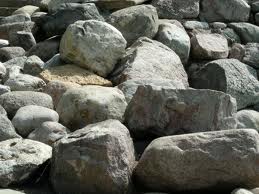 |
The mining of rocks for their metal ore content has been one of the most important factors of human advancement, which has progressed at different rates in different places in part because of the kind of metals available from the rocks of a region.
The prehistory and history of civilization is classified into the Stone Age, Bronze Age, and Iron Age. Although the Stone Age has ended virtually everywhere, rocks continue to be used to construct buildings and infrastructure. When so used, rocks are called dimension stone.
Based on current consumption, it is estimated that you - and every other person in the United States - will use more than a million pounds of rocks, minerals and metals during your lifetime including:
- 800 pounds of lead - Primarily used in the construction of batteries. Also used as a radiation shielding during x-ray treatment by your doctor and dentist and as a protective shield on your TV screen to protect you from radiation from that source.
- 750 pounds of zinc - primarily used as a rust inhibitor for steel in the construction of cars, buildings, bridges, ships and trains.
- 1,500 pounds of copper - Primarily used in the manufacture of copper wire to conduct electricity needed in your car, home, office, school, church, appliances.
- 3,600 pounds of aluminum - Cans, aircraft and automobile construction, sporting and electronic equipment, appliances.
- 32,000 pounds of iron - Used to make steel for cars, subways, ships, cans, building construction, heavy equipment, appliances, power transmission turbines and towers.
- 27,000 pounds of clays - Used to coat the pages of newspapers magazines, stationery, brochures and boxes so that the ink used in printing on them will be bright and will not run. Also used as a brightener and abrasive in toothpaste and to provide a smooth coating for your stomach in medicines.
- 28,000 pounds of salt - Used in food preservation (almost all canned and frozen food contain salt), to enhance the taste of foods and to melt the ice on streets and highways during the winter. Also used in the manufacture of many chemicals, for water treatment, papermaking, soaps & detergents and in petroleum refining.
- 1,000,000 pounds of stone, sand, gravel and cement - Use in streets, highways and sidewalks; in the foundation for your house and school; as decorative materials for yards and gardens; in water purification plants to protect your health and in the construction of buildings from the most modest of homes to the world's tallest skyscrapers.
|
|
